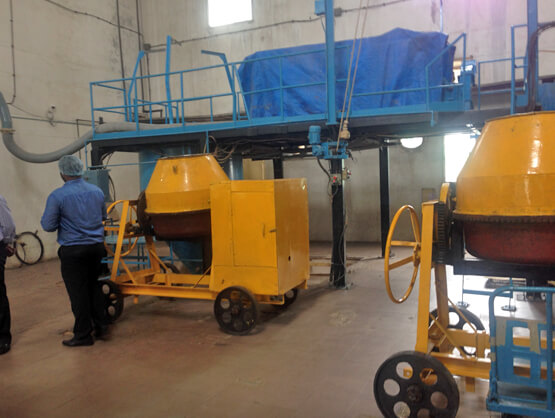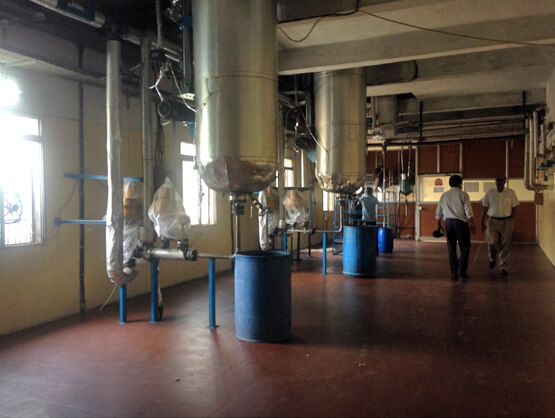Second Report from India: The Tea Decaffeination Plant
Posted by Aubrey @ Arbor Teas on 28th Aug 2015
After Jeremy and our kids left to return home, I continued to Hyderabad, Telangana. In Hyderabad, I visited Spisys Ltd, the facility that decaffeinates our tea, and met its Managing Director Mr. J. Sobhanadri. Located on the outskirts of Hyderabad, Spisys decaffeinates tea using “Super Critical Fluid Extraction Technology” (SCFE), better known as the “Carbon Dioxide (CO2) Decaffeination” process.
 The carbon dioxide (CO2) decaffeination process is one of two
decaffeination methods that are permitted for use with
organic certified teas. The
other permitted method is the “Water Decaffeination” method. At Arbor Teas, we choose
to use the carbon dioxide (CO2) method to decaffeinate our teas because we feel
that it is the safest form of decaffeination, while retaining the greatest
flavor and health benefits. We also support the CO2 decaffeination method
because the CO2 used for decaffeination can be filtered and recycled at a rate
of around 99%, and emits very little CO2 into the atmosphere. Additionally, the
CO2 can be captured and repurposed. For example, Spisys captures the caffeine
and sells it in powder form as a caffeine additive to be incorporated into
other food items such as soft drinks.
The carbon dioxide (CO2) decaffeination process is one of two
decaffeination methods that are permitted for use with
organic certified teas. The
other permitted method is the “Water Decaffeination” method. At Arbor Teas, we choose
to use the carbon dioxide (CO2) method to decaffeinate our teas because we feel
that it is the safest form of decaffeination, while retaining the greatest
flavor and health benefits. We also support the CO2 decaffeination method
because the CO2 used for decaffeination can be filtered and recycled at a rate
of around 99%, and emits very little CO2 into the atmosphere. Additionally, the
CO2 can be captured and repurposed. For example, Spisys captures the caffeine
and sells it in powder form as a caffeine additive to be incorporated into
other food items such as soft drinks.
When I visited Spisys, Mr. Sobhanadri was preparing to
decaffeinate tea for us at Arbor Teas. He gave me a tour of the facility and
explained each step of the decaffeination process. Unlike tea growing and manufacturing
in India, which is an expansive process that involves many people, the
decaffeination process is very contained and only requires a handful of
employees. The facility consists of a labyrinth of tubes and pipes that connect
various vessels throughout the two-story building. Tea grown and processed
anywhere in the world can be decaffeinated at this facility, but the majority
of the tea decaffeinated is grown and manufactured in India.
After the tea is grown and processed into its final form
(black, green, oolong or white) at the tea estate, it is transported to Spisys,
where it is stored in a holding room. Because the plant only works with one
product at a time (to prevent cross contamination of flavors and scents), the
holding room was filled with tea when I visited, while the rest of the plant
was in the process of being cleaned after an extended run using ginger. And,
no, the ginger was not being decaffeinated! Originally, Spisys was not a
decaffeination facility. In fact, its roots were in herbal and spice extracts,
as the same Super Critical Fluid Extraction Technology is used for both
decaffeination
and extraction.
After the facility is thoroughly cleaned (which can take
upwards of 3 days), the tea is moved from the holding room into a wetting room
where a small amount of water is added to the tea in large barrel shaped
mixers. The water is added in very precise quantities that are constantly
adjusted so that the most minimal amount of water is used. The water is added
to open up the tea leaf and begin to extract the caffeine from inside the tea
leaf. Even though this decaffeination process is called “CO2 Decaffeination”,
the carbon dioxide cannot actually remove the caffeine from
inside the tea leaf. Only water can extract
the caffeine from inside the leaf.
 Once the tea leaves are wet and allowed to
rest, the tea is moved into larger cone shaped containers that hold the tea
while it is bathed in a highly regulated sequence of carbon dioxide (in a super
critical state) and moisture to continue the process of removing the caffeine.
Once the tea leaves are wet and allowed to
rest, the tea is moved into larger cone shaped containers that hold the tea
while it is bathed in a highly regulated sequence of carbon dioxide (in a super
critical state) and moisture to continue the process of removing the caffeine.
This step in the decaffeination process is when the true art
of decaffeination takes place. Similar to tea manufacturing, decaffeinating tea
is a craft that is honed over the course of many years of trial and error. To
simply remove caffeine is one thing, but to remove caffeine while retaining the
flavor and color of the tea leaf is
very
difficult. The skill of the decaffeinator is what can differentiate a flavorful
cup of decaf tea from one that is not. It requires an artful monitoring of
pressure gauges that have to be adjusted and re-adjusted constantly depending
on moisture content, type of tea, shape of the leaf, etc.
Finally, after the tea is tested and passes the required
caffeine levels (or lack thereof) the tea is dried and allowed to rest for up
to 48 hours. Interestingly, if the tea is packaged too soon after drying, any remaining
CO2 on the tea leaf can cause effervescence in the final cup, just like
carbonation!
I hope you enjoyed this latest installment from our travels
in India – stay tuned for another installment coming soon!


